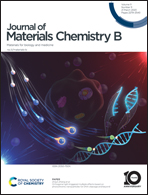Second near-infrared photoactivatable nanomedicines for enhanced photothermal–chemodynamic therapy of cancer†
Abstract
Nanomedicines have been widely used for cancer therapy, while controlling their activity for effective and safe treatment remains a big challenge. Herein, we report the development of a second near-infrared (NIR-II) photoactivatable enzyme-loaded nanomedicine for enhanced cancer therapy. Such a hybrid nanomedicine contains a thermoresponsive liposome shell loaded with copper sulfide nanoparticles (CuS NPs) and glucose oxidase (GOx). The CuS nanoparticles mediate the generation of local heat under 1064 nm laser irradiation, which not only can be used for NIR-II photothermal therapy (PTT), but also leads to the destruction of the thermal-responsive liposome shell to achieve the on-demand release of CuS nanoparticles and GOx. In a tumor microenvironment, GOx oxidizes glucose to produce hydrogen peroxide (H2O2) that acts as a medium to promote the efficacy of chemodynamic therapy (CDT) by CuS nanoparticles. This hybrid nanomedicine enables the synergetic action of NIR-II PTT and CDT to obviously improve efficacy without remarkable side effects via NIR-II photoactivatable release of therapeutic agents. Such a hybrid nanomedicine-mediated treatment can achieve complete ablation of tumors in mouse models. This study provides a promising nanomedicine with photoactivatable activity for effective and safe cancer therapy.



 Please wait while we load your content...
Please wait while we load your content...